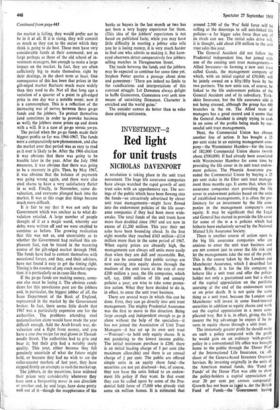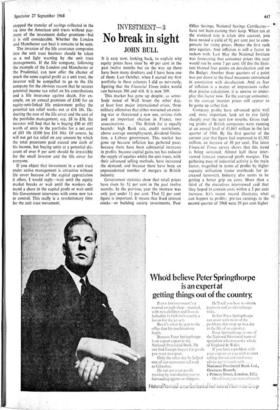Red light for unit trusts
INVESTMENT-2 NICHOLAS DAVENPORT
A revolution is taking place in the unit trust movement. The huge life assurance companies have always watched the rapid growth of unit trust sales with an apprehensive eye. The sav- ings of the public which have been flowing into the funds—so attractively advertised by clever unit trust managements—might have flowed into the endowment policies of the life assur- ance companies if they had been more wide- awake. The total funds of the unit trusts have more than doubled since 1965 and are now in excess of i1,200 million. This year their net sales have been bouncing ahead. In the first eight months they reached £163 million—£114 million more than in the same period of 1967. When equity prices are absurdly high, the managements can always sell units more easily than when they are dull and reasonable. But, if it can be assumed that public savings are now moving into equity shares through the medium of the unit trusts at the rate of over £200 million a year, the life companies, which sell, say, £800 million of life and annuity policies a year, are wise to take some protec- tive action. What they have decided to do is, in effect, to enter the unit trust business.
There are several ways in which this can be done. First, they can go directly into unit trust management. The mighty Prudential Assurance was the first to move in this direction. Being large enough and independent enough to go it alone without the help of the specialists—it has not joined the Association of Unit Trust Managers—it has set up its own unit trust —Trutrusf—to hold only equity shares. It is not pandering to the lowest income public. The initial minimum purchase is £200, there is an initial loading charge of 5 per cent (the maximum allowable) and there is an annual charge of 1 per cent. The public are offered simple units in an equity share fund—the securities are not yet disclosed—but, of course, they can have the units linked to an endow- ment life policy if they want. In that event they can be called upon by some of the Pru- dential field force of 17,000 who already visit some six million homes. It is estimated that around 2,500 of the `Pm' field force will be calling at the doorsteps to sell unit-linked life policies—a far bigger sales force than any of its rivals can use. The initial sales drive will it is thought, add about £50 million to the unit trust sales this year.
The General Accident did not follow the Prudential independent line, but joined with one of the existing unit trust managements— Allied InVestors—in forming e new unit trust called Ganda, the management company of which, with an initial capital of £50,000, will be jointly owned on a fifty/fifty basis by the two partners. The new units can, of course, be linked to the life endowment policies of the General Accident and of its subsidiary, York- shire Insurance, but the life assurance side is not being stressed, although the group has 400 branches in the ux. The Allied team of managers has a good record and it seems that the General Accident is simply trying to cash in on some of the profits being made by suc- cessful unit trust managements.
Next, the Commercial Union has chosen another line of action. It has bought a 25 per cent stake in an existing management com- pany—the Westminster Hambro—for the issue of 182,000 Commercial Union shares (worth about £500,000). It had already been associated with Westminster Hambro for some time by providing the life cover in its unit trust endow- ment policies. The Phoenix Assurance pre- ceded the Commercial Union by buying a 25 per cent stake in the Ebor unit trust manage- ment three months ago. It seems that, when life assurance companies start providing the life cover in endowment policies based on the units of established managements, it is often the pre- liminary for an investment by the life com- panies in the management company's own equity. It may be significant that the Legal and General has started to provide the life cover for some of the M & G policies which had hitherto been exclusively served by the National Mutual Life Assurance Society.
There is another course of action open to the big life assurance companies who are anxious to enter the unit trust business and are not content just to cover the life risk and let the managements take the rest of the profit. This is the course 'taken by the London and Manchester Assurance, which I described last week. Briefly, it is for the life company to behave like a unit trust and offer the policy- holder not only a guaranteed sum but a share of the capital appreciation on the portfolio accruing at the' end of the endowment term or on prior death. It is not quite the same thing as a unit trust, because the London and Manchester will invest in some fixed-interest securities in addition to equity shares and work out the capital appreciation in a more com- plicated way. But it is, in effect, giving the life insurer the big advantage he- enjoys if he in- vests in equity shares through a unit trust. The immensely greater profit he should make on such a policy compared with the profit he would gain on an ordinary 'with-profits' policy in a conventional life office was brought home to the public through the 'Dover Plan' of the International Life Insurance, ux off- shoot of the Geneva-based Investors Overseas Services. By investing originally in the units of the American mutual funds, this 'Fund of Funds' of the Dover Plan was able to show the policy-holders a capital appreciation of over 20 per cent per annum compound! Growth has not been so rapid u-der the- British Fund of Funds—the Government having
stopped the transfer of savings collected in the UK into the American unit trusts without pay- ment of the investment dollar premium—but it is still considerable. Whether the London and Manchester can beat it remains to be seen.
The invasion of the life assurance companies into the unit trust business should be taken as a red light warning by the unit trust managements. If the life company, following the example of the London and Manchester or the Prudential, can now offer the chance of much the same capital profit as a unit trust, the investor will be compelled to go to the life company for the obvious reason that he secures potential income tax relief on his contributions and a life insurance against death. For ex- ample, on an annual premium of £100 for an equity-unit-linked life endowment policy the potential tax relief works out at £16 10s. De- ducting the cost of the life cover and the cost of the portfolio management, say, £8 to f10, the investor will find that he is buying £90 or £92 worth of units in the portfolio for a net cost of £83 lOs (£100 less £16 10s). Of course, he will not get tax relief on any amount by which the total premiums paid exceed one sixth of his income, but buying units at a potential dis- count of over 9 per cent should be irresistible for the small investor and the life cover for everyone.
If you object that investment in a unit trust under active management is attractive without life cover because of the capital appreciation it offers, I would reply—wait until the equity market breaks or wait until the workers de- mand a share in the capital profit or wait until this Government intervenes with some new tax or control. This really is a revolutionary time for the unit trust movement.











































 Previous page
Previous page